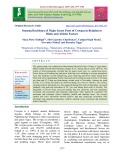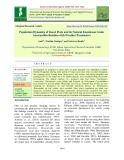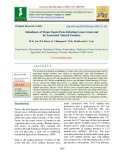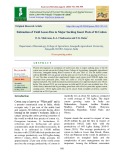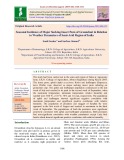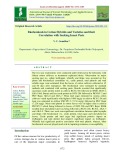
Major sucking insect pests
-
Field studies were undertaken at Agricultural Research Farm, Darsi, Andhra Pradesh to study the comparative bio-efficacy of cow based (dung and urine) fermented organic products viz., neemastra, brahmastra and agniastra at 20% along with Neem Seed Kernel Extract (NSKE) 5 % against the major pests of castor and their safety to natural enemies during 2016-17. NSKE 5% recorded least no. of mean larval population of Achaea janata (1.06 plant-1 )...
 9p
9p  chauchaungayxua10
chauchaungayxua10
 19-03-2021
19-03-2021
 21
21
 1
1
 Download
Download
-
Survey was conducted in major pomegranate growing area of Tharad, Deodar and Bhabhar talukas of Banaskantha district in Gujarat during mrig bahar season by using of multistage ramdom methods. Population of anar butterfly, fruit suckin moth, thrips, whitefly and aphid was observed during the period of study.
 4p
4p  trinhthamhodang9
trinhthamhodang9
 16-12-2020
16-12-2020
 17
17
 2
2
 Download
Download
-
The present study was conducted at Horticultural Research Farm, College of Agriculture, Indira Gandhi KrishiVishwavidyalaya; Raipur (C.G.) during kharif season 2015-16. The results of field experiments revealed that the major insect pest viz., spotted pod borer, flower thrips, pod sucking bug and green stink bug were attacking in cowpea germplasm Lola.
 8p
8p  nguathienthan8
nguathienthan8
 20-10-2020
20-10-2020
 8
8
 2
2
 Download
Download
-
This experiment was conducted to understand the biochemical and anatomical differences in the highly resistant and susceptible recombinant inbred lines (RILs) of cotton for sucking pests. These factors are considered to play a major role in the resistance mechanism against insects.
 12p
12p  nguaconbaynhay8
nguaconbaynhay8
 13-10-2020
13-10-2020
 11
11
 2
2
 Download
Download
-
Investigation on incidence of insect pests on grain amaranth was undertaken at MRS, Hebbal, Bengaluru. During study period, 19 insect pests have been recorded throughout the cropping period. Among these, Stem weevil, leaf webber, leaf eating caterpillar and sucking pests are the major one. Five natural enemies were recorded during the present investigation.
 9p
9p  caygaocaolon7
caygaocaolon7
 18-09-2020
18-09-2020
 10
10
 1
1
 Download
Download
-
The present investigation on abundance of major insect-pests infesting green gram and its associated natural enemies was carried at Instructional farm and Department of Entomology, Rajasthan College of Agriculture, MPUAT, Udaipur. Green gram variety SML-668 was sown on 18th July during kharif 2015 and 16th July during kharif 2016 with the seed rate of 15 kg/ ha; maintaining a row to row and plant to plant spacing of 30 cm x 10 cm, respectively. Major insect pests, viz., aphids, Aphis craccivora (Koch); jassids, Empoassca spp.
 10p
10p  gaocaolon5
gaocaolon5
 14-06-2020
14-06-2020
 15
15
 1
1
 Download
Download
-
Rice (Oryza sativa) productivity is adversely impacted by numerous biotic and abiotic factors. An approximate 52% of the global production of rice is lost annually owing to the damage caused by biotic factors, of which ~21% is attributed to the attack of insect pests. We have developed transgenic pyramided rice lines, endowed with enhanced resistance to major sap sucking insects, through sexual crosses made between two stable transgenic rice lines containing Allium sativum (ASAL) and Galanthus nivalis (GNA) lectin genes.
 11p
11p  trinhthamhodang1213
trinhthamhodang1213
 30-05-2020
30-05-2020
 14
14
 0
0
 Download
Download
-
Present investigation on estimation of yield losses due to major sucking pests of the Bt cotton was carried out on the College Farm, College of Agriculture, Junagadh Agricultural University, Junagadh during Kharif season of the year 2011-12. The Bt hybrid cotton cultivar KDCHH-441 was grown with the plot size of 24 m X 20 m at spacing of 120 cm x 45 cm. The data revealed that significantly higher seed cotton yield 2038.82 kg/ha was recorded from protected plots, while the yield of 1312.70 kg/ha was recorded from unprotected plots.
 4p
4p  angicungduoc4
angicungduoc4
 26-04-2020
26-04-2020
 7
7
 0
0
 Download
Download
-
The study had been carried out in the semi-arid region of India at Agronomy farm, S.K.N. College of Agriculture, Jobner (Rajasthan) during Kharif 2018. The insect pests, aphid (Aphis craccivora Koch) and leafhopper (Empoasca kerri Pruthi) were observed as major sucking insect pests infesting on groundnut crop. The aphid and leafhopper population commenced in the last week of July and reached to its peak in the second week of September, when the maximum temperature, minimum temperature, relative humidity and rainfall were 30.0 oC, 21.0 oC, 78% and 1.6 mm, respectively.
 6p
6p  cothumenhmong3
cothumenhmong3
 22-02-2020
22-02-2020
 16
16
 1
1
 Download
Download
-
The two year experiments were conducted under field and in the laboratory with fifteen cotton cultivars as treatments replicated thrice. Observation on major sucking pest viz., aphid, leafhopper, whitefly and thrips were recorded on five plants and biochemical constituent viz., crude protein, total phenols and total soluble sugar were estimated from the leaves of cotton cultivars collected at 45 and 60 days after emergence. The biochemical were estimated by standard methods and correlated with sucking pests.
 12p
12p  nguaconbaynhay3
nguaconbaynhay3
 07-02-2020
07-02-2020
 10
10
 1
1
 Download
Download
-
Relative efficacy of different biorational insecticides against major insect pest on brinjal was evaluated in field condition at the Horticulture Farm of Agricultural College and Research Institute, Killikulam, Thoothakudi during Kharif from July to October. The results showed that the two applications of Buprofesin 25SC (0.8 ml/lit) was found significantly most effective, which caused maximum population reduction of sucking insect pest of brinjal leaf hopper, 78.78, aphid, 81.24, and whitefly, 80.86 per cent. It was followed by Emamectin benzoate 5 WG (0.4 g/lit) with 74.27, 71.73 and 70.
 7p
7p  nguathienthan2
nguathienthan2
 26-12-2019
26-12-2019
 10
10
 0
0
 Download
Download
CHỦ ĐỀ BẠN MUỐN TÌM











